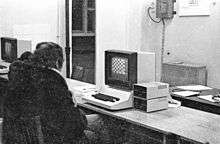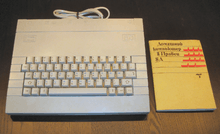Pravetz computers
Pravetz (Правец in the original Cyrillic, series 8 and series 16) were Bulgarian computers, manufactured mainly in the town of Pravetz. Some components and software were produced in Stara Zagora, Plovdiv, and other Bulgarian cities.
Native name | Правец |
|---|---|
| Public | |
| Industry | Computer hardware Electronics |
| Founded | 1979 (Pravets) (restored 2013) |
| Founder | Ivan Marangozov |
| Headquarters | Pravets, Bulgaria , now Sofia, Bulgaria |
Area served | Bulgaria |
| Products | Desktops, servers, notebooks, netbooks |
| Website | www |
History
The first Bulgarian-made personal computer, IMKO-1, was a prototype of the Pravetz computers that were developed by Ivan Vassilev Marangozov,[1] who was rightfully accused of cloning the Apple II. In fact, IMKO-1 was a nearly identical clone of the original Apple 2 with a few minor exceptions - case, keyboard, char table (lower case Latin alphabet was replaced with Cyrillic upper case) and power supply (early models used bulky and heavy linear power supplies). A few early models were produced at the ITKR (pronounced ee-teh-kah-reh, Institute of Technical Cybernetics and Robotics), a section of the Bulgarian Academy of Sciences. Industrial production in Pravetz started shortly after.[2]
The line of Bulgarian personal computers at the time of release, was prohibitively expensive for individuals and in addition were only sold to different government institutions - educational sector, military and administrative sector.
Pravetz computers were of major importance in the economy of the Comecon.
In October 2013, a privately held Bulgarian company claimed in their website to have the rights on the trademark and misleadingly announced that "Pravetz Computers are returning to market". In fact, the company has no link to the original "Pravetz" computers known during the Soviet Era.
Model line
8-bit architecture


Except for the Oric-derived 8D (and possibly the IMKO-1), all the Pravetz 8-bit systems are largely compatible with the popular Apple II and its successors, with the exception that they offer Cyrillic fonts and some other improvements compared to Apple.
- IMKO-1 — First Bulgarian personal computer. Used a clone of the 6502 CPU 1 MHz CPU, and 16/4 KB RAM/ROM. The storage media is a cassette recorder. It had a metal case and very large and heavy linear power supply. The ROM was an exact copy of the Apple 2 ROM (the only change was the name).
- Pravetz 82 (IMKO-2) - 82 is the model year. BASIC interpreter, RAM/ROM - 48/12 KB; CPU Synertek 6502 /1 MHz. The storage is improved due to the availability of (optional) 5.25" floppy disk drive(s). They had yellow plastic case and black keyboards. The later revisions used switching power supplies. ROM and schematics were not changed and were identical to those of the Apple II. A lot of the chips used were Bulgarian and Soviet substitutes (clones) of the original chips. Pravetz 82 was relatively reliable - most of the hardware problems were due to the widespread use of sub-standard quality IC sockets, mainly used for the DRAM chips.
- Pravetz 8М - Integrated second CPU Zilog Z80A at 4 MHz to be able to run CP/M and its software. The military version features integrated terminal design. It was essentially a version of Apple II+ with the optional CP/M card integrated on the motherboard. It had 64K of RAM on-board, a switching power supply and an off-white plastic case with an improved design.
- Pravetz 8E - Industrial model based on the original Pravetz 82 architecture plus some memory extensions
- Pravetz 8А - Uses Bulgarian-made chipset СМ 630, memory could be expanded up to 1 Mb using optional memory card, accessible in 64Kb banks. It was a nearly identical clone of Apple //e on electrical diagrams and ROM content levels. The case was similar to the one used for the 8M model. The keyboard was improved with arrow buttons, and the Char table included Cyrillic upper and lower case symbols. This was the most advanced model with the greatest level of upgradeability.
- Pravetz 8С - "streamlined version" of the 8А model. 128 KB RAM integrated, but not expandable. Fewer slots, but all essential controllers were integrated on the motherboard - Parallel (Centronics) interface, FDD controllers, Joystick and sometimes with RS-232. A version of 8C is the Pravetz 8VC, which features a terminal-like design.
- Pravetz 8D - 8 bit home computer, based on 6502 and VIA 6522. It used a TV set instead of a computer monitor. Not compatible with Pravetz 82 but inherits its architecture from the French Oric Atmos home computers and compatible with their software.
16-bit architecture
Pravetz-16 were IBM PC compatible:
- Pravetz-16 (IMKO-4) - Featured Intel 8088 at 4 MHz. Simple motherboard design with Bulgarian chipset. Standard RAM 256KB or 512KB expandable to 640KB.
- Pravetz-16E
- Pravetz-16ES (variations as a desktop or tower box) - Featured the 80186 processor at 8 MHz.
- Pravetz-16A
- Pravetz-16T - Turbo version
- Pravetz-286
32-bit architecture
- Pravetz-386
- Pravetz-486
Pravetz 64M
In October 2013, a private company announced that it will use the Pravetz logo to brand its new computers in 2014.
References
- (in Bulgarian) Иван Василев Марангозов, pomagaloto.com, Материал № 54889, добавен на 9 декември 2007
- (in Bulgarian) The history... Facts concerning Bulgarian microcomputers